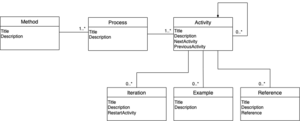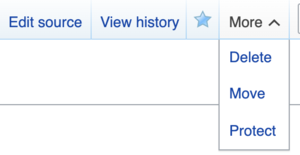HowTo
This HowTo provides guidance to create, edit, or delete process and activity descriptions on this Wiki.
Basic Idea
Scientific methods are core for any scientific discipline. By defining a standardized set of research activities, they enable researchers to build scientific knowledge. They explain how to make valid observations, how to interpret results, and how to generalize those results. Furthermore, scientific methods allow other researchers to test pre-existing theories and prior findings independently [1] . The Information Systems (IS) field is characterized by a pluralism of scientific methods [2] . Many different research methods are leveraged by IS researchers to contribute to the IS body of knowledge. For example, prominent methods in IS are case study research, experimental research, and survey-based research. This diversity of research methods within the discipline is a positive source of strength [3] but also leads to some challenges in managing and applying them. Knowledge on research methods and the descriptions of the specific research activities are scattered in different books or other publications. Furthermore, research methods evolve and can have different levels of maturity, or even new branches emerge depending on the specific research approaches.
In this Wiki, together with the IS community, we aim to provide an overview of well-established, state-of-the-art, and common grounded research methods in the field of IS. In turn, this will safeguard the quality and improve the contribution of findings in research projects. We particularly believe that our research method descriptions and the tool will be used to explore research methods and improve method accuracy in IS research and beyond.
Documentation Process
In this Wiki we propose a research method documentation structure containing the following three main concepts: Method, Process, and Activity. The underlying meta-model of this structure is illustrated in the figure: Research Methods Meta-Model.
Examples for such methods are literature review research [4] , case study research [5] , or design science research [6] .
A process is a set, mostly in a predefined order, of activities. Each method can contain one or more processes with different characterizations. For example, the different approaches in design science research (DSR) literature [7] [8] [9] . Activities describe what has to be done in a specific process e.g. definition of review scope as part of the literature review process [10] or problem identification & motivation in the design science research process according to Peffers et. al [11] .
Create a new Research Process
Open the method where you want to create a new process and provide a process name in the text field. By clicking on the button 'New Process' a new wiki page will be generated. The new process page will contain some empty activity templates that can be filled out. If more activity templates are needed you can use the activity template by adding the following code{{subst:Activity}}
Edit an Existing Research Process
You can edit an existing research process by logging in and then use 'Edit' in the top menu in order to edit the whole document or choose 'Edit' in a document section.
To rename an existing research process you need to select 'Move' from the 'More' menu at the top and provide a new name for the process description.
If you want to delete an existing research process you have to choose the 'Delete' item in the 'More' menu at the top.
Create a new Research Method.
New research methods can be created by one of the administrators. Please get in contact with one of our operational editors if you need to create a new method.
Invite Collaborators
As a department editor, you can invite as many process editors as you want. You only have to add the eMail address of the collaborator in the following list:Invited Editors
More Help about MediaWiki
General help about the media wiki and its functionality can be found on the official documentation page of MediaWiki.
How to add citations in MediaWiki
Reference
- ↑ Bhattacherjee, A. 2012. Social Science Research: Principles, Methods, and Practices, (Vol. Textbooks Collection. 3. http://scholarcommons.usf.edu/oa_textbooks/3).
- ↑ Mingers, J. 2001. “Combining IS Research Methods: Towards a Pluralist Methodology,” Information Systems Research (12:3), INFORMS, pp. 240–259. (https://doi.org/10.1287/isre.12.3.240.9709).
- ↑ Orlikowski, W. J., and Robey, D. 1991. “Information Technology and the Structuring of Organizations,” Information Systems Research (2:2), INFORMS, pp. 143–169. (https://doi.org/10.1287/isre.2.2.143).
- ↑ Webster, Jane and Watson, Richard T.. 2002. "ANALYZING THE PAST TO PREPARE FOR THE FUTURE: WRITING A LITERATURE REVIEW," MIS Quarterly, (26: 2).
- ↑ Yin, R. K. 1981. “The Case Study as a Serious Research Strategy,” Knowledge (3:1), SAGE Publications, pp. 97–114. (https://doi.org/10.1177/107554708100300106).
- ↑ Hevner, A. R., March, S. T., Park, J., and Ram, S. 2004. “Design Science in Information Systems Research,” MIS Quarterly (28:1), pp. 75–105. (https://doi.org/10.2307/25148625).
- ↑ Kuechler, B., and Vaishnavi, V. 2008. “On Theory Development in Design Science Research: Anatomy of a Research Project,” European Journal of Information Systems (17:5), Taylor & Francis, pp. 489–504. (https://doi.org/10.1057/ejis.2008.40).
- ↑ Peffers, K., Tuunanen, T., Rothenberger, M. A., and Chatterjee, S. 2007. “A Design Science Research Methodology for Information Systems Research,” Journal of Management Information Systems (24:3), Taylor & Francis Ltd, pp. 45–77. (https://doi.org/10.2753/MIS0742-1222240302).
- ↑ Sein, M. K., Henfridsson, O., Purao, S., Rossi, M., and Lindgren, R. 2011. “Action Design Research,” MIS Quarterly (35:1), pp. 37–56. (https://doi.org/10.2307/23043488).
- ↑ vom Brocke, J., Simons, A., Niehaves, Bjoern, Niehaves, Bjorn, Reimer, K., Plattfaut, R., and Cleven, A. 2009. “RECONSTRUCTING THE GIANT: ON THE IMPORTANCE OF RIGOUR IN DOCUMENTING THE LITERATURE SEARCH PROCESS,” ECIS 2009 Proceedings (161. https://aisel.aisnet.org/ecis2009/161). (https://aisel.aisnet.org/ecis2009/161).
- ↑ Peffers, K., Tuunanen, T., Rothenberger, M. A., and Chatterjee, S. 2007. “A Design Science Research Methodology for Information Systems Research,” Journal of Management Information Systems (24:3), Taylor & Francis Ltd, pp. 45–77. (https://doi.org/10.2753/MIS0742-1222240302).

